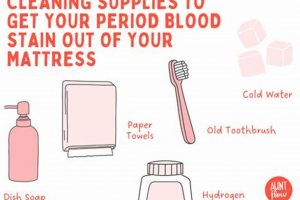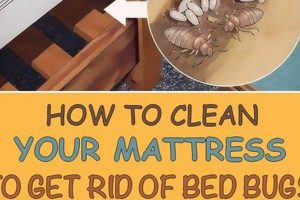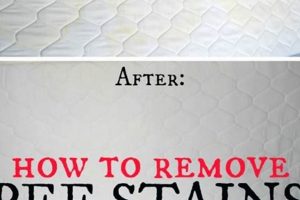The process of removing discoloration from a sleeping surface focuses on eliminating visual blemishes and addressing potential underlying issues such as lingering odors or bacterial growth. Effective stain removal contributes to the hygiene and longevity of the bedding.
Maintaining a clean sleeping environment offers significant advantages, including improved sleep quality and reduced exposure to allergens and potential pathogens. Historically, methods for cleaning mattresses have evolved from rudimentary techniques employing sunlight and simple cleaning agents to more sophisticated approaches utilizing specialized solutions and equipment.
The subsequent sections detail practical steps and recommended products for successfully addressing various types of discoloration on mattresses, ensuring a restored and sanitized sleeping surface.
Mattress Stain Removal Guidance
The following recommendations provide a structured approach to address discoloration on mattresses, ensuring effective cleaning and promoting hygiene.
Tip 1: Immediate Action: Address stains promptly. Fresh stains are generally easier to remove than those that have set.
Tip 2: Blot, Do Not Rub: When treating a spill, use a clean cloth to blot the affected area gently. Rubbing can spread the stain and damage the mattress fibers.
Tip 3: Utilize Cold Water: Opt for cold water rather than hot water. Hot water can cause certain stains, particularly protein-based ones, to set permanently.
Tip 4: Employ Baking Soda: Baking soda is a natural deodorizer and absorbent. Sprinkle it liberally over the stain, allow it to sit for several hours, and then vacuum thoroughly.
Tip 5: Hydrogen Peroxide Application: For persistent stains, consider a diluted hydrogen peroxide solution (3%). Test in an inconspicuous area first to ensure it does not discolor the mattress.
Tip 6: Enzyme Cleaners for Organic Stains: Enzyme-based cleaners are effective for breaking down organic stains, such as blood, urine, or vomit. Follow the product instructions carefully.
Tip 7: Sun Exposure: If feasible, expose the mattress to direct sunlight after cleaning. Sunlight possesses natural sanitizing and bleaching properties.
Adhering to these guidelines maximizes the likelihood of successful stain removal, preserving the integrity and cleanliness of the mattress.
The subsequent section addresses common stain types and specific treatments tailored to each.
1. Identify the Stain
Accurate identification of the staining agent directly impacts the selection of appropriate cleaning methods and products. The effectiveness of any stain removal process depends significantly on correctly diagnosing the cause of the discoloration. For example, an enzymatic cleaner designed to break down proteins is well-suited for blood or urine stains but will prove ineffective against grease or ink.
Failure to identify the stain can result in the application of unsuitable cleaning agents, potentially setting the stain further or causing damage to the mattress material. Conversely, correct identification allows for a targeted approach, maximizing the chances of successful removal. Consider the difference between treating a coffee stain with a general-purpose cleaner versus using a solution specifically formulated to break down tannins, the compounds responsible for coffee’s discoloration. The latter approach yields demonstrably superior results.
In summary, stain identification serves as the foundational step in any mattress cleaning protocol. Understanding the nature of the staining agent enables the selection of appropriate cleaning solutions and techniques, thereby optimizing the outcome and preserving the mattress’s integrity. The consequences of misidentification can range from ineffective cleaning to permanent damage, highlighting the critical importance of accurate assessment.
2. Appropriate Cleaning Agents
The selection of cleaning agents stands as a critical determinant in the effective execution of stain removal from mattresses. The inherent characteristics of the staining substance dictate the type of solvent or reactive compound required to break down its molecular structure and facilitate its removal. Employing an inappropriate cleaning agent can not only prove ineffective but may also exacerbate the problem, leading to permanent discoloration or damage to the mattress fibers. For example, attempting to remove an oil-based stain with a water-based cleaner will likely result in spreading the stain and embedding it further into the material. Conversely, using a solvent-based cleaner on a water-soluble stain may unnecessarily expose the mattress to harsh chemicals.
The effectiveness of appropriate cleaning agents is demonstrated through the application of enzymatic cleaners to treat biological stains. These cleaners contain enzymes that specifically target and digest proteins found in substances like blood, urine, and vomit. This targeted approach avoids the need for harsh chemicals that could damage the mattress while ensuring thorough stain removal. Similarly, utilizing a specialized upholstery cleaner designed for delicate fabrics can prevent damage to the mattress ticking, preserving its structural integrity and aesthetic appeal. Understanding the chemical properties of both the stain and the cleaning agent is essential for achieving optimal results and preventing unintended consequences.
In conclusion, the judicious selection of cleaning agents is paramount to successful stain removal from mattresses. A mismatch between the stain type and the cleaning agent can lead to ineffective cleaning or even permanent damage. By carefully considering the nature of the stain and choosing the appropriate chemical solution, individuals can maximize their chances of effectively removing the stain while preserving the integrity of the mattress. This understanding highlights the practical significance of informed decision-making in mattress care and maintenance.
3. Blotting Technique
The blotting technique plays a crucial role in mattress stain removal. It involves applying gentle pressure to the stain with an absorbent material to lift the staining agent without spreading it further into the mattress fibers. This approach is fundamentally different from rubbing or scrubbing, which can exacerbate the stain and damage the mattress.
- Minimizing Stain Spread
Blotting restricts the stain to a localized area, preventing it from permeating a larger portion of the mattress. Rubbing, conversely, forces the staining agent deeper into the fibers and expands the affected area. The use of a clean, white cloth or paper towel is recommended to visually monitor stain transfer and prevent dye transfer from the cleaning material to the mattress.
- Preserving Mattress Integrity
Aggressive scrubbing can damage the surface fibers of the mattress, leading to pilling, fraying, or even tearing. Blotting, being a gentler method, helps maintain the structural integrity and extends the lifespan of the mattress. This is particularly important for mattresses with delicate fabrics or intricate constructions.
- Enhancing Absorbency
Applying consistent, downward pressure during blotting maximizes the absorbent material’s contact with the stain. This encourages the capillary action that draws the staining agent away from the mattress fibers. The effectiveness of blotting can be further enhanced by using highly absorbent materials such as microfiber cloths or specialized stain-absorbing pads.
- Facilitating Cleaning Agent Penetration
After blotting to remove excess liquid, a cleaning agent can be applied. Blotting the area again after applying the cleaning agent helps to draw the stain and cleaner out of the mattress. This cyclical process, alternating between application and blotting, can be more effective than simply spraying and leaving the cleaner to dry.
The blotting technique, therefore, is an indispensable component of any effective mattress stain removal strategy. It minimizes stain spread, preserves the mattress integrity, enhances absorbency, and facilitates cleaning agent penetration. Mastering this technique significantly increases the likelihood of successful stain removal and extends the lifespan of the mattress.
4. Complete Drying
The thorough desiccation of a mattress following stain removal is not merely a concluding step but an integral component of the entire remediation process. The failure to completely dry a mattress after stain removal directly undermines the efforts expended in cleaning, creating a conducive environment for microbial growth and potential material degradation. Residual moisture within the mattress core provides an ideal breeding ground for mold, mildew, and bacteria, which can lead to unpleasant odors, allergic reactions, and long-term damage to the mattress structure. For instance, a mattress that remains damp after cleaning blood stains can develop persistent musty odors and potentially harbor harmful bacteria, necessitating costly professional cleaning or even replacement.
The practical significance of complete drying extends beyond preventing microbial growth. Retained moisture can also lead to the breakdown of the mattress’s internal components, such as foam or fiber fillings. This degradation can compromise the support and comfort provided by the mattress, reducing its lifespan. Proper drying techniques, including the use of fans, dehumidifiers, or even sunlight exposure (when appropriate), are crucial to ensure that all moisture is eliminated from the mattress interior. Furthermore, the type of cleaning agent used can impact the drying time; certain solvents or solutions may require longer evaporation periods than others. Regular inspection of the mattress for any lingering dampness is recommended to ensure complete dryness has been achieved.
In summary, complete drying is not a perfunctory step but a critical element of stain removal. It mitigates the risk of microbial growth, preserves the structural integrity of the mattress, and ensures a healthy sleep environment. The absence of complete drying negates the benefits of stain removal, potentially leading to long-term damage and health concerns. Therefore, dedicating sufficient time and resources to thorough drying is paramount for successful mattress stain remediation and maintenance.
5. Preventative Measures
Proactive steps implemented to safeguard a mattress against stains significantly reduce the necessity for extensive stain removal procedures. Minimizing the occurrence of stains through strategic prevention is often more efficient and cost-effective than reactive cleaning methods.
- Mattress Encasements
These zippered covers fully enclose the mattress, providing a physical barrier against liquids, allergens, and dust mites. A waterproof encasement effectively prevents spills from penetrating the mattress core, thereby eliminating the potential for stain formation. For example, utilizing a mattress encasement in a household with young children can mitigate the impact of accidental spills or bedwetting incidents.
- Mattress Protectors
Unlike encasements, protectors typically cover only the top surface of the mattress. While offering less comprehensive protection, they provide a significant defense against surface stains and spills. A mattress protector can absorb minor spills before they reach the mattress itself, preventing discoloration and odor absorption. The use of a breathable mattress protector also helps regulate temperature, preventing moisture buildup that can contribute to stain development.
- Regular Cleaning and Maintenance
Routine vacuuming of the mattress surface removes dust, debris, and potential staining agents before they can become embedded in the fibers. Periodic spot cleaning of minor spills or stains prevents them from setting and becoming more difficult to remove. This proactive approach minimizes the accumulation of dirt and liquids, reducing the overall likelihood of significant staining.
- Limiting Food and Drink in Bed
Restricting the consumption of food and beverages in bed reduces the risk of accidental spills that can lead to stubborn stains. Establishing a clear boundary between sleeping and eating/drinking areas minimizes the potential for mishaps. This simple behavioral modification can drastically decrease the frequency of mattress staining incidents.
These preventative strategies, when consistently implemented, collectively minimize the incidence and severity of mattress stains. By reducing the need for aggressive stain removal techniques, these measures contribute to the longevity and hygiene of the mattress, ensuring a cleaner and more comfortable sleeping environment.
Frequently Asked Questions
This section addresses common inquiries and concerns related to stain removal from mattresses, providing objective information and practical guidance.
Question 1: What is the most effective first step when encountering a fresh stain on a mattress?
The immediate application of a clean, dry cloth to blot the spill is paramount. This action minimizes the absorption of the liquid into the mattress fibers, thereby reducing the stain’s severity and facilitating subsequent cleaning efforts.
Question 2: Are all cleaning agents suitable for use on mattresses, and how does one determine the appropriate choice?
Not all cleaning agents are compatible with mattress materials. It is essential to identify the stain type and select a cleaning agent specifically formulated for that purpose. Testing the chosen agent on an inconspicuous area of the mattress prior to full application is advised to assess potential discoloration or damage.
Question 3: What are the potential consequences of failing to completely dry a mattress after stain removal?
Incomplete drying fosters a conducive environment for microbial growth, including mold and mildew. This can lead to unpleasant odors, allergic reactions, and degradation of the mattress structure. Ensuring thorough desiccation is crucial for maintaining hygiene and preventing long-term damage.
Question 4: How frequently should a mattress be cleaned to prevent stain accumulation?
The frequency of cleaning depends on usage and environmental factors. However, a general recommendation is to vacuum the mattress monthly to remove dust and debris. Spot cleaning should be performed promptly upon the occurrence of any spills or stains.
Question 5: Is professional mattress cleaning necessary, and under what circumstances is it recommended?
Professional cleaning is advisable for persistent or extensive stains, as well as for individuals with allergies or sensitivities. Professional services possess specialized equipment and cleaning agents that can effectively remove deeply embedded stains and allergens.
Question 6: Do mattress protectors genuinely offer protection against stains, and what are the different types available?
Mattress protectors provide a tangible barrier against spills and stains. Options range from basic waterproof covers to more advanced encasements that fully enclose the mattress, offering comprehensive protection against liquids, allergens, and dust mites.
The information presented in these FAQs underscores the importance of prompt action, appropriate cleaning techniques, and preventative measures in maintaining a stain-free and hygienic mattress.
The following section provides a summary of the key takeaways from this article.
Conclusion
The preceding discussion comprehensively addressed the methodologies involved in stain extraction from mattresses. Key areas explored include the necessity of prompt action, accurate stain identification, the selection of appropriate cleaning agents, the utilization of the blotting technique, and the imperative of complete drying. Additionally, preventative measures, such as the use of mattress protectors and regular cleaning protocols, were emphasized as critical components of long-term mattress maintenance.
Effective stain management is essential for preserving the hygiene and longevity of mattresses. Implementation of the described strategies reduces the accumulation of allergens and microorganisms, promoting a healthier sleep environment. Consistent application of these principles represents a tangible investment in both the durability of the mattress and the well-being of its user.







